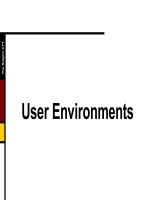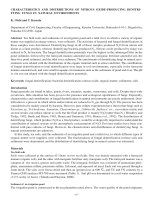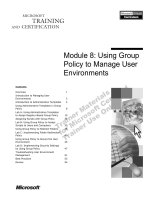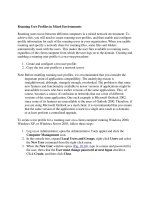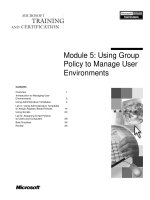Metamorphic environments
Bạn đang xem bản rút gọn của tài liệu. Xem và tải ngay bản đầy đủ của tài liệu tại đây (5.94 MB, 44 trang )
Chapter 8 Lecture
Earth: An Introduction
to Physical Geology
Eleventh Edition
Metamorphism and
Metamorphic Rocks
Tarbuck and Lutgens
© 2014 Pearson Education, Inc.
Metamorphism
© 2014 Pearson Education, Inc.
Rock Environments
© 2014 Pearson Education, Inc.
Metamorphic Environments
© 2014 Pearson Education, Inc.
What Is Metamorphism?
Metamorphism
Changes rock via temperatures and/or pressures unlike
those in which it initially formed
All metamorphic rocks have a parent rock (the rock from
which it formed)
Parent rocks can be igneous, sedimentary, or other
metamorphic rocks.
© 2014 Pearson Education, Inc.
Metamorphic Grade
Change occurring during metamorphism
Progresses from low grade (low temperatures and
pressures) to high grade (high temperatures and
pressures)
• During metamorphism, the rock must remain
essentially solid
© 2014 Pearson Education, Inc.
Metamorphic Grade
© 2014 Pearson Education, Inc.
What Drives Metamorphism?
Heat
Most important agent
Two sources of heat:
Geothermal gradient: an increase in temperature with
depth (about 25o C per kilometer)
Contact metamorphism: rising mantle plumes
© 2014 Pearson Education, Inc.
What Drives Metamorphism?
Confining Pressure
Forces are applied equally in all directions
Causes the spaces between mineral grains to close
© 2014 Pearson Education, Inc.
What Drives Metamorphism?
Differential Stress
Forces are unequal in different directions
Compressional stress
Rocks are squeezed as if in a vice
Shortened in one direction and elongated in the
other direction
© 2014 Pearson Education, Inc.
Confining Pressure and Differential Stress
© 2014 Pearson Education, Inc.
What Drives Metamorphism?
Chemically Active Fluids
Enhances migration of ions
Aids in recrystallization of existing minerals
© 2014 Pearson Education, Inc.
Metamorphic Textures - Foliated
Rock or slaty cleavage
Split into thin slabs
Low-grade metamorphism
© 2014 Pearson Education, Inc.
Metamorphic Textures -Foliated
Schistosity
Platy minerals (mica) are visible
Exhibit a planar or layered structure
Rocks having this texture are referred to as schist
© 2014 Pearson Education, Inc.
Metamorphic Textures - Foliated
Gneissic texture
High-grade metamorphism, segregation of minerals into light
and dark bands
Metamorphic rocks with this texture are called gneiss
Gneiss does not split as easily as slates and schists
© 2014 Pearson Education, Inc.
Metamorphic Textures - Nonfoliated
Nonfoliated composed of minerals that lack
layering/foliation
© 2014 Pearson Education, Inc.
Metamorphic Textures - Porphyroblastic
Porphyroblastic textures
Large grains (porphyroblasts) surrounded by a finegrained matrix of other minerals
© 2014 Pearson Education, Inc.
Common Metamorphic Rocks
Foliated Rocks
Slate
Very fine-grained
Excellent rock cleavage
Most often generated from low-grade metamorphism
of shale, mudstone, or siltstone
© 2014 Pearson Education, Inc.
Common Metamorphic Rocks
Foliated Rocks
Phyllite
Degree of metamorphism between slate and schist
Platy minerals are larger than slate but not large
enough to see with the unaided eye
Glossy sheen and wavy surfaces
Exhibits rock cleavage
© 2014 Pearson Education, Inc.
Common Metamorphic Rocks
Foliated Rocks
Schist
Medium- to coarse-grained
Parent rock is shale that has undergone medium- to
high-grade metamorphism
The term schist describes the texture
Platy minerals (mainly micas) predominate
Can also contain porphyroblasts
© 2014 Pearson Education, Inc.
Common Metamorphic Rocks
Foliated Rocks
Gneiss
Medium- to coarse-grained metamorphic rock with a
banded appearance
The result of high-grade metamorphism
Composed of light-colored, feldspar-rich layers with
bands of dark ferromagnesian minerals
© 2014 Pearson Education, Inc.
Increasing Metamorphic Grade
© 2014 Pearson Education, Inc.
Common Metamorphic Rocks
Nonfoliated Rocks
Marble
Crystalline rock from limestone or dolostone parent rock
Main mineral is calcite
Calcite is relatively soft (3 on the Mohs scale)
Used as a decorative and monument stone
Impurities in the parent rocks provide a variety of colors
© 2014 Pearson Education, Inc.
Non-foliated Marble
© 2014 Pearson Education, Inc.
Marble Quarries in Italy
© 2014 Pearson Education, Inc.

